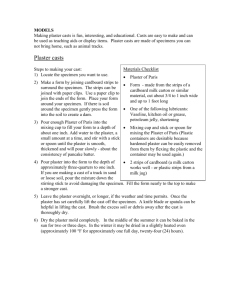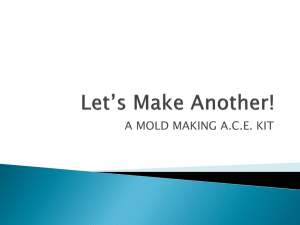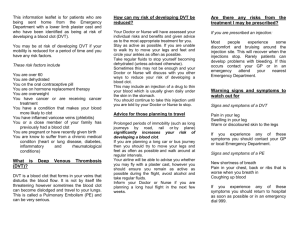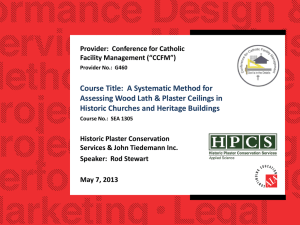plaster handout
advertisement
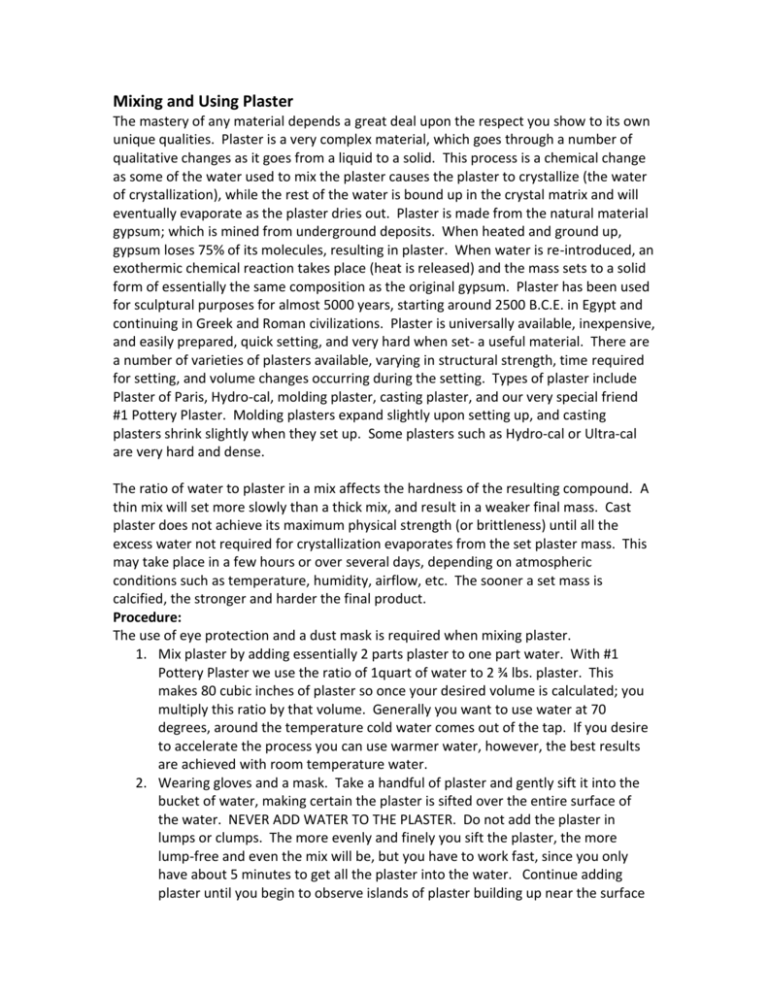
Mixing and Using Plaster The mastery of any material depends a great deal upon the respect you show to its own unique qualities. Plaster is a very complex material, which goes through a number of qualitative changes as it goes from a liquid to a solid. This process is a chemical change as some of the water used to mix the plaster causes the plaster to crystallize (the water of crystallization), while the rest of the water is bound up in the crystal matrix and will eventually evaporate as the plaster dries out. Plaster is made from the natural material gypsum; which is mined from underground deposits. When heated and ground up, gypsum loses 75% of its molecules, resulting in plaster. When water is re-introduced, an exothermic chemical reaction takes place (heat is released) and the mass sets to a solid form of essentially the same composition as the original gypsum. Plaster has been used for sculptural purposes for almost 5000 years, starting around 2500 B.C.E. in Egypt and continuing in Greek and Roman civilizations. Plaster is universally available, inexpensive, and easily prepared, quick setting, and very hard when set- a useful material. There are a number of varieties of plasters available, varying in structural strength, time required for setting, and volume changes occurring during the setting. Types of plaster include Plaster of Paris, Hydro-cal, molding plaster, casting plaster, and our very special friend #1 Pottery Plaster. Molding plasters expand slightly upon setting up, and casting plasters shrink slightly when they set up. Some plasters such as Hydro-cal or Ultra-cal are very hard and dense. The ratio of water to plaster in a mix affects the hardness of the resulting compound. A thin mix will set more slowly than a thick mix, and result in a weaker final mass. Cast plaster does not achieve its maximum physical strength (or brittleness) until all the excess water not required for crystallization evaporates from the set plaster mass. This may take place in a few hours or over several days, depending on atmospheric conditions such as temperature, humidity, airflow, etc. The sooner a set mass is calcified, the stronger and harder the final product. Procedure: The use of eye protection and a dust mask is required when mixing plaster. 1. Mix plaster by adding essentially 2 parts plaster to one part water. With #1 Pottery Plaster we use the ratio of 1quart of water to 2 ¾ lbs. plaster. This makes 80 cubic inches of plaster so once your desired volume is calculated; you multiply this ratio by that volume. Generally you want to use water at 70 degrees, around the temperature cold water comes out of the tap. If you desire to accelerate the process you can use warmer water, however, the best results are achieved with room temperature water. 2. Wearing gloves and a mask. Take a handful of plaster and gently sift it into the bucket of water, making certain the plaster is sifted over the entire surface of the water. NEVER ADD WATER TO THE PLASTER. Do not add the plaster in lumps or clumps. The more evenly and finely you sift the plaster, the more lump-free and even the mix will be, but you have to work fast, since you only have about 5 minutes to get all the plaster into the water. Continue adding plaster until you begin to observe islands of plaster building up near the surface of the water. Use all the plaster you have measured out. The plaster should look damp and gray. DO NOT STIR THE PLASTER DURING THIS PROCESS. Once all the plaster is added, wait 3 minutes without disturbing the mix. This will allow the plaster to become completely wet and help to drive out any air bubbles. 3. Next you can very slowly blunge the plaster with a mixing attachment on the drill or place a gloved hand into the plaster and move it to the bottom of the bucket. Stir the plaster gently and thoroughly until smooth. The hand is the best mixing tool- you can feel lumps and squeeze out plaster between the fingers. Do not stir vigorously as this accelerates the setting of the plaster and introduces air into the plaster mix. I usually mix for exactly 3 minutes and I time it. If strength in your finished plaster is the most important factor, longer mixing times are suggested. 4. The plaster is ready to pour when there is a barely visible line/wake in the plaster from your finger running across the top. This is the beginning of the Thick Cream Stage. Once the stirring begins, never add more plaster or more water. If by mistake too much plaster is added and the batch thickens too fast, it is better to dispose of that batch and start over. If the plaster is too thick when poured, your registration will suffer. Don’t let this happen, just throw the batch away and start over. Stages of plaster The plaster as it sets will go through several stages as it turns from a liquid to a solid. At each of these stages the plaster will be useful to do various sculptural processes. Depending on the temperature of the mixing water and the room, the plaster will set up solid in approximately 15-20 minutes. Thick Cream Stage The plaster should be like a milkshake- thick and creamy, with a surface shine. It will be slick and very pourable. If you are pouring plaster into any mold to cast a form, you should pour it into your prepared mold at the beginning of this stage. Be sure to pour down the side of your mold to minimize aeration. One trick is to use a spray bottle filled with isopropyl alcohol to sprits the top of the wet plaster just before you pour it, to break the surface tension and pop any bubbles. Once poured, tap the mold container against the table (gently) or against the sides of the container surface to release any remaining trapped air, and coax bubbles out of the plaster mass to the surface. For casting purposes, it is best not to disturb the plaster once it has begun to set up (beyond thick cream) as this will result in a weaker final mold. Your batch of plaster should allow for your entire mold pouring to be completed within 5 minutes after the slurry has been mixed. If you are making a plaster mold pouring at the thick cream stage is essential for mold making and to allow you to capture amazing detail. If you are coloring the plaster, the pigment should be mixed into the plaster at this time. If you are making large sale molds lighter with paper pulp, your initial layers should be poured now then pulp added and that mix applied on top. Whipped Margarine Stage The plaster now has become a little stiffer. It will cling to an armature wire quite well, will stay put on a vertical surface, and even underneath a surface. Plaster will stay on the blade of a spatula. This is the stage when the main body of a mold should be built up or the main form roughed out when directly modeling with plaster, but it is too late to pour a mold. Though it is possible to re-liquefy the plaster as it enters this stage by vigorously stirring it, this breaks some of the forming bonds, and results in a weaker final block. Butter Stage The plaster is now quite firm, like room temperature butter in the winter. It is very pliable at the stage and is ideal for building thickness is a mold or on an armature, but work fast. Divinity Candy Stage The plaster has a dry grainy surface appearance. Small cracks appear as you apply it. The plaster is still workable at this stage, but only for rough building. It cannot be used for detail work. Time to manipulate the plaster is running out! Cheese Stage The plaster becomes very stiff, hard to manipulate, and has a cheesy consistency as it approaches crystallization. It is very difficult to get it to stick to itself. If you have lots of plaster left at this stage, you have either mixed too much or worked too slowly. Do not use the plaster at this point. Throw it away. Dump it straight into the dumpster. The Solid Stage The plaster will now get quite hard and the chemical crystallization process will cause it to heat up. You may observe water vapor steaming from the surface. At this point the hardest plasters such as Hydro-cal will be so hot they can burn your skin. You now can only carve the plaster with a saw or rasp. Separating mold, removing positive It is ideal to wait a few hours to try to take a multi-part mold apart after your mold is solid. If you trust your mix is a good one, the mold will be very hard after a few hours. At this pint you will want a wide chisel and hammer to pry the mold apart. This requires patience, never force a mold apart from one side. Gently ease the sides apart. Remove your positive and put the mold together to cure. Do not clean the mold with water until the mold is cured. If you used lubrication (often necessary) wipe your mold surfaces with vinegar before using. Paper pulp/plaster molds I have made molds a in to two part process whereby they are initially registered with plaster at the thick cream stage then paper pulp is quickly added to the remaining plaster and this is added by building up the mold using the frosting method. This allows one to make large-scale molds, to not use mold walls for pouring and to make molds that in the end are significantly lighter. The drawback to this method is that the molds take a very long time to dry/cure.


![First Aid Training : Bronze [Power Point]](http://s2.studylib.net/store/data/005424634_1-e0b0e5e602f7c1666ebc2e9ff3f4a1b5-300x300.png)
